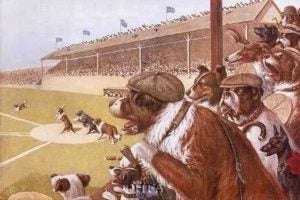
Learning Objectives
Students will be able to make inferences using details in a picture and their prior knowledge.
Grade Levels
K-2
Common Core Standard
CCSS.ELA-LITERACY.RL.1
Ask and answer such questions as who, what, where, when, why, and how to demonstrate understanding of key details in a text.
CCSS.ELA-LITERACY.RL.3
Describe how characters in a story respond to major events and challenges.
CCSS.ELA-LITERACY.RL.7
Use information gained from the illustrations and words in a print or digital text to demonstrate understanding of its characters, setting, or plot.
Materials Needed
“One to Tie Two to Win” by Cassius Marcellus Coolidge
Paintings by Cassius Marcellus Coolidge (one for each group)
Lesson
Introduction
- Tell students that they will be learning about how to make inferences when looking at paintings.
- Remind them that an inference is an idea that is created by using your background knowledge and evidence from the text or a picture.
- Explain that making inferences from paintings is different than making inferences from text. When making inferences while reading, it’s important to use text evidence and what you already know. When making inferences from art, it’s important to use details and what you already know.
Explicit Instruction/Teacher Modeling
- Display the painting “One to Tie Two to Win” by Cassius Marcellus Coolidge.
- Explain that even though there aren’t any words to tell you what is going on in this painting, you can use evidence in the painting and what you already know to infer what is happening.
- Using details from the painting and what you already know, make inferences about what is happening. For example, you may say that you infer that there is a baseball game going on because a dog is at bat and other dogs are cheering.
- Record these inferences with your evidence on your inference chart.
- Using resources on akc.org, have students identify the breeds that are depicted in the painting. Reiterate that all details are important when making inferences.
Guided Practice/Interactive Modeling
- Have students discuss other inferences they could make from this painting.
- Discussion questions include: Why do you think the artist drew that? What do you think is happening right now in the picture? How do you think the dogs in the picture feel?
- Once students are able to support their findings with evidence, split them into small groups. Give each group a new painting from Cassius Marcellus Coolidge to analyze and an inference chart. Tell students that they should make inferences using these paintings and then record their supporting evidence on their inference chart.
- Walk around the room, assisting groups and helping them form deeper inferences from their evidence.
Independent Working Time
- Ask students to choose an independent reading book to read.
- Students should make inferences and support their findings with evidence from the pictures and/or the text in their books.
Review and Closing
- Have students share about the book they read and one inference they made on their chart.
- Remind students that whenever they read they need to remember to use what they already know and evidence from the text or pictures to make inferences.
References
American Kennel Club. (n.d.) Retrieved from www.akc.org.
Coolidge, C.M. (1910). One to Tie, Two to Win. Norfolk, VA: Chrysler Museum of Art.

